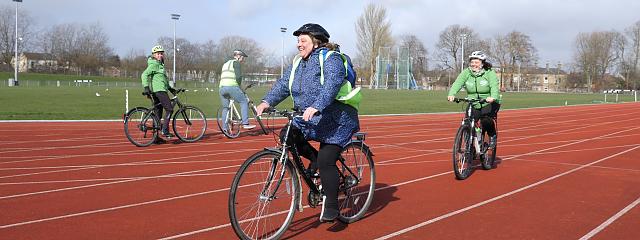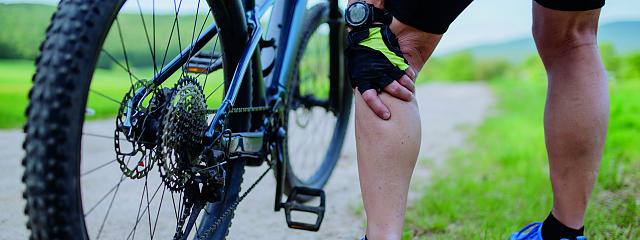
Q&As: your health and cycling – circulatory
Q&As: your health and cycling – circulatory
Warfarin and cycling
Q I have had to start warfarin medication. This thins the blood, so wounds will bleed more and a head injury can be dangerous. Health officials have suggested that biking is rather risky. My life is built around cycling for utility, sociability and holidays.
I wonder what views Cycling UK may have regarding any extra risk posed by warfarin for cyclists, in particular any extra validity in wearing a helmet (I always do anyway)?
Ruth Feinberg
A Warfarin is an anticoagulant used to prevent and treat blood clots in a range of conditions where clots have formed or are likely to form, such as deep vein thrombosis (DVT), pulmonary embolism (PE) and atrial fibrillation (irregular heartbeat), and in those with mechanical heart valves.
Although I don’t have any figures, the overall risk of cycling while on warfarin is likely to be significantly less than that associated with not treating the underlying medical condition for which it has been prescribed. That said, there is obviously a higher risk of bleeding if you fall off.
In most instances, this will mean that you bruise more easily and have to apply extra pressure to any cuts. If you are unlucky enough to suffer major trauma, then there is a greater chance of more serious bleeding.
People who take warfarin require regular INR blood tests to ensure the dosage is correct. The INR indicates how thin your blood is in comparison to ‘normal’ (that is, somebody not taking warfarin). The desired INR depends on the condition being treated (2-3 is a typical range but a few conditions require it to be higher). It is important to attend all your INR tests as the risk of bleeding is much greater if the INR gets too far above the desired range.
My advice is to keep cycling but take a few precautions. Ride sensibly (downhill mountain bike racing is probably not ideal). Wearing a helmet seems like a good idea, but don’t let it make you feel over-confident and take extra risks. Some also advocate wearing additional protective gear like knee padding. This is a personal decision which will depend on your attitude to risk and the type of biking you do.
Dr Matt Brooks
First published in the February/March 2013 issue of Cycle magazine.
High blood pressure
Q A year ago, an over-65’s health check (I am 70) showed that I have high blood pressure: around 169/81 with a pulse of 52. I was prescribed Amlodipine 5mg tablets and my blood pressure has dropped to around 145/73. But I suffered several unpleasant side effects, the worst being shortage of breath, especially when climbing hills, plus some muscle fatigue and leg cramps.
It got to the point where I felt I might have to give up riding with my club. (I do a road ride of 40 miles or so every weekend and a mountain bike ride of about 20 miles every Thursday.) When I mentioned this to my doctor, she suggested coming off the tablets for a couple of weeks. I did and felt 10 years younger; I could easily keep up with the fastest riders in the group.
I think this shows that amlopidine is not suitable for me. Is there anything else I could use for my blood pressure? I feel that my doctor does not understand the effects of these pills on cyclists.
WH Jackson
A Hypertension (high blood pressure) is a common medical problem which is important as it increases the risk of other conditions including heart attack and stroke. It usually refers to a blood pressure above 140/90. Treatment is through a combination of lifestyle factors – such as a healthy diet, regular exercise, not smoking and maintaining a normal BMI – and medication.
Those medicines used for hypertension tend to be grouped together based on their mechanism of action. Amlodipine is a calcium-channel blocker.
Other frequently used classes of drug are ACE inhibitors (such as lisinopril and ramipril) and thiazide diuretics (for example, indapamide and bendroflumethiazide). Beta-blockers (including atenolol) and alpha-blockers (such as doxazosin) are also used although not usually as first-line treatment.
All medications have side effects but many of these are relatively minor and it is important to remember that a particular side effect will not affect everyone taking a given drug. As you mention, some side effects are not too troublesome and can often be tolerated. However, given the problems that you have experienced with shortness of breath while taking amlodipine, it would seem sensible to try another drug.
NICE provides some clear guidance on treatment of hypertension. In your age group, the next drug to try would be an ACE inhibitor such as lisinopril or ramipril, assuming there are no contra-indications.
There is always an element of trial and error in the process as it is not always possible to predict which of us will get troublesome side effects with any given medication. It is, however, usually possible to find one or more drugs which are both effective at controlling your blood pressure and acceptable to you in terms of adverse effects.
Dr Matt Brooks
First published in the April/May 2014 issue of Cycle magazine.
Heart-rate spikes
Q I have been alarmed by some readings on my heart-rate monitor. I am a fit, 63-year-old cyclist. My maximum heart rate used to be around 180, but I’ve had the odd spike above 200.
Normally, these spikes occur near the start of a ride; when I slow down they pass and rarely reoccur. I discussed this with my GP who, after a 24-hour monitor, pronounced me fit and well. Last night, I did a 10-mile time trial without warming up properly. My HR quickly went up to about 220, and stayed high for a few minutes. My options now seem to be:
- Go back to my GP and demand more tests/referral to specialist
- Cut back on high-intensity riding
- Carry on regardless
I’d welcome your advice.
K Murison
A If we assume that your heart-rate monitor is correct (not always the case, so it may be worth trying another one to confirm your findings), then I think this requires further attention. Various methods can be used to calculate maximum predicted heart rate, most of which give similar but slightly different estimates. Since all individuals vary, they can only ever be estimates.
One rule-of-thumb formula, which has been around for many years, is ‘220 – age’. By this method, your predicted maximum rate would be 157bpm (beats per minute), well below the 220bpm you have been experiencing. Therefore, the implication would be that your 220bpm may be abnormal.
Presence of any other cardiac symptoms such as chest pain, breathlessness or dizziness would add further weight to this argument. It is also important to know whether your resting heart rate and rhythm are normal and whether you get any palpitations at other times.
From your question, I believe that you have had a 24-hour ECG performed. If this was normal, I wonder whether you went cycling during the time you wore the monitor and, if so, whether your heart rate went up to 220bpm during that period?
I would encourage you to go back and talk to your GP again, taking your data with you. Your GP should consider your heart monitor readings alongside any symptoms, examination findings, and the results of tests done so far. Your doctor will then be able to advise you regarding any further cardiac investigation that may be required. In the meantime, I suggest you ease off the high-intensity riding.
Dr Matt Brooks
First published in the December 2015/January 2016 issue of Cycle magazine.
Heart rate too low?
Q I’m struggling to get my heart rate into the target zones when I’m training. I take propranolol 40mg twice a day prophylactic to reduce migraine. I understand it slows heart rate; my max HR has reduced and resting HR is 15-20 less than prior to taking medication. Will I ever be able to get into my zones again? I was able to reach them a few years ago when I wasn’t on beta blockers.
Helen Shaw
A Beta-blockers (such as propranolol and bisoprolol) are a group of drugs that are used to treat several heart problems, including angina, irregular heart rhythms and heart failure. They also treat high blood pressure and a range of other conditions, including prevention of migraine. One of the effects of a beta-blocker is to slow the heart rate. The extent to which it does this varies depending on the drug and dosage used and also on the individual taking it.
Although your heart rate will still increase with exercise when you are taking a beta-blocker, you should not expect to be able to achieve the same maximum heart rate during exercise that you did before. Despite this, you will still be getting a good cardiovascular workout – albeit at a lower heart rate.
It is therefore probably better not to worry about a target heart rate but keep it simple: exercise hard but without overdoing it. Aim to feel physically tired without pushing yourself to the point of exhaustion.
Since many side effects of beta-blockers are dose specific, if your migraines are well-controlled on your current dose of propranolol, you could talk to your GP about reducing the dose gradually until you are on the minimum which controls your headaches effectively.
Dr Matt Brooks
First published in the August/September 2016 issue of Cycle magazine.
Cycling with anaemia
Q I’ve found myself exhausted for days after harder-than-usual rides. I’ve also noticed that I’m prone to viral infection. A blood test revealed that I am slightly anaemic (13.2g/dl). My GP has asked for another test in three months. At 65, I wish to carry on cycling. Must I stop/reduce the long, hard rides to prevent ‘crashing’?
Eric Gorton
A Anaemia is the term used for levels of haemoglobin in the blood which are below normal. Haemoglobin binds oxygen, so anaemia results in less oxygen being carried around the body. Symptoms include feeling breathless, dizzy and tired. The severity of symptoms will, in part, depend on the level of anaemia.
Red blood cells are made in the bone marrow, and a constant new supply is needed to replace old cells that break down. This requires a healthy bone marrow and nutrients including iron and some vitamins such as vitamin B12 and folic acid.
A one-off haemoglobin level just below normal needs repeating as it may be transient. However, if the anaemia is persistent or worsening, investigation will be required to identify the cause. Your GP can do blood tests to check iron stores, vitamin B12 and folate levels. Other tests may be required – for instance, looking for possible blood loss in iron-deficiency anaemia.
Iron-deficiency anaemia may be due to: blood loss (for instance, from the bowel); pregnancy or heavy menstrual periods in women; poor diet; or poor absorption of iron such as in coeliac disease. Other causes of anaemia include folic acid and vitamin B12 deficiency, red blood cell disorders, bone marrow problems and chronic conditions like rheumatoid arthritis or kidney disease.
Treatment of anaemia depends on the cause but may involve iron tablets or vitamin B12 injections. In mild anaemia, symptoms are likely to be less problematic although this will depend on factors such as your general fitness and other health conditions. You may have to reduce longer more strenuous rides to compensate but if the cause for your anaemia is identified and treated, this may only be temporary.
Dr Matt Brooks
First published in the December 2017/January 2018 issue of Cycle magazine.
Meet the expert
Dr Matt Brooks was Cycle magazine’s health expert for 10 years to 2018. A GP and a keen cyclist he has a wealth of knowledge when it comes to cycling and health.














